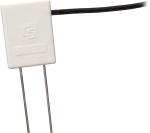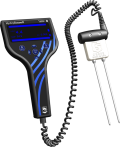
Designed for long-term monitoring






Overview
The CS616 measures the volumetric water content from 0% to saturation. The probe outputs a megahertz oscillation frequency, which is scaled down and easily read by a Campbell Scientific datalogger. Refer to the Compatibility section for datalogger compatibility.
Read MoreBenefits and Features
- Compatible with most Campbell Scientific data loggers
- High accuracy and high precision
- Fast response time
- Designed for long-term unattended water content monitoring
- Compatible with AM16/32-series multiplexers, allowing measurement of multiple sensors
- Probe rods can be inserted from the surface or buried at any orientation to the surface.
Technical Description
The CS616 is comprised of two 30-cm-long stainless steel rods connected to the measurement electronics. The circuit board is encapsulated in epoxy, and a shielded four-conductor cable is connected to the circuit board to supply power, enable probe, and monitor the output.
The CS616 measures the volumetric water content of porous media (such as soil) using the time-domain measurement method; a reflectometer (cable tester) such as the TDR100 is not required. This method consists of the CS616 generating an electromagnetic pulse. The elapsed travel time and pulse reflection are then measured and used to calculate soil volumetric water content.
Response Characteristics
The signal propagating along the parallel rods of the CS616 is attenuated by free ions in the soil solution and conductive constituents of the soil mineral fraction. In most applications, the attenuation is not enough to affect the CS616 response to changing water content, and the response is well described by the standard calibration. However, in soil with relatively high soil electrical conductivity levels, compacted soils, or soils with high clay content, the calibration should be adjusted for the specific medium. Guidance for making these adjustments is provided in the operating manual.
Images

Compatibility
Please note: The following shows notable compatibility information. It is not a comprehensive list of all compatible products.
Dataloggers
| Product | Compatible | Note |
|---|---|---|
| CR1000 (retired) | ||
| CR1000X (retired) | ||
| CR1000Xe | ||
| CR300 (retired) | ||
| CR3000 | ||
| CR310 | ||
| CR350 | ||
| CR6 | ||
| CR800 (retired) | ||
| CR850 (retired) |
Additional Compatibility Information
RF Considerations
The RF emissions are below FCC and EU limits as specified in EN61326 if the CS616 is enabled less than 0.6 ms, and measurements are made less frequently than once a second. External RF sources can also affect the CS616 operation. Consequently, the CS616 should be located away from significant sources of RF such as ac power lines and motors.
Installation Tool
The CS650G makes inserting soil-water sensors easier in dense or rocky soils. This tool can be hammered into the soil with force that might damage the sensor if the CS650G was not used. It makes pilot holes into which the rods of the sensors can then be inserted. It replaces both the 14383 and 14384.
Data Logger Considerations
The reflectometer connects directly to one of the data logger’s single-ended analog inputs. A data logger control port is typically used to enable the CS616 for the amount of time required to make the measurement. Data logger instructions convert the probe square-wave output to period which is converted to volumetric water content using a calibration.
Specifications
| Measurements Made | Volumetric water content (VWC) of porous media (such as soil) |
| Measurement Range | 0% to saturation |
| Water Content Accuracy | ±2.5% VWC (using standard calibration with bulk EC of ≤ 0.5 dS m-1, bulk density of ≤ 1.55 g cm-3, and measurement range of 0% to 50% VWC) |
| Required Equipment | Measurement system |
| Soil Suitability | Long rods and lower frequency are well-suited for soft soil with low electrical conductivity (< 2 dS/m). |
| Rods | Not replaceable |
| Sensors | Not interchangeable |
| Operating Temperature Range | 0° to +70°C |
| Probe-to-Probe Variability | ±0.5% VWC in dry soil, ±1.5% VWC in typical saturated soil |
| Precision | Better than 0.1% VWC |
| Resolution | 0.1% VWC |
| Output | ±0.7 V square wave (with frequency dependent on water content) |
| Current Drain |
|
| Power Supply Voltage | 5 Vdc minimum; 18 Vdc maximum |
| Enable Voltage | 4 Vdc minimum; 18 Vdc maximum |
| Electromagnetic | CE compliant (Meets EN61326 requirements for protection against electrostatic discharge.) |
| Rod Spacing | 32 mm (1.3 in.) |
| Rod Diameter | 3.2 mm (0.13 in.) |
| Rod Length | 300 mm (11.8 in.) |
| Probe Head Dimensions | 85 x 63 x 18 mm (3.3 x 2.5 x 0.7 in.) |
| Cable Weight | 35 g per m (0.38 oz per ft) |
| Weight | 280 g (9.9 oz) without cable |
Resources and Links
Product Brochures
Technical Papers
Compliance
FAQs for
Number of FAQs related to CS616: 31
Expand AllCollapse All
-
Each CS616 connects to a single-ended analog input channel, so a maximum of 16 CS616 reflectometers may be connected to the wiring panel of a CR1000. For more than 16, consider using a multiplexer such as the AM16/32B. With a multiplexer, it is possible to read 48 CS616 reflectometers using only three single-ended analog input channels of the CR1000.
-
Yes, as long as the data logger can detect a ±700 mV square wave over a frequency range of 29 to 67 kHz.
-
No. The output is too fast to be measured on the pulse channel of a 21X or CR7.
-
Fine roots do not significantly affect the CS616/CS625 reading.
-
Yes. For program examples and guidance on using a multiplexer with one of these reflectometers, see the CS616 and CS625 instruction manual.
-
If a soil-specific calibration is performed, the CS616/CS625 may be used in soil with a maximum bulk electrical conductivity of 5 dS/m.
-
Some customers have tried to use the CS616 or CS625 to measure the moisture content within a tree, but the calibration proved to be problematic. Campbell Scientific cannot provide any specific guidance for this application.
-
The cable for the sensors is rugged and resistant to damage from the sun and typical weather conditions. However, it is susceptible to damage from rodents, machinery, shovels, and so forth. Running the cable through electrical conduit or PVC pipe will help protect it, but this is not an absolute requirement. In areas where rodent activity is low, direct burial in a trench is usually sufficient. A particularly vulnerable location is where the buried cables exit the ground and enter the enclosure housing the data logger. At that exit point, take steps to protect the cable from damage.
-
Yes, but the CS616/CS625 will need a soil-specific calibration. The high organic matter content of peat will likely cause the CS616/CS625 period to be out of bounds for use with the CS616() CRBasic instruction and P138 Edlog instruction. In that situation, the CRBasic PeriodAvg() instructionor the Edlog P27 Period Average instruction may be used as described in the CS616 and CS625 instruction manual.
-
Yes. The dielectric permittivity of water varies with temperature, which will cause the CS616/CS625 period to decrease with increasing temperature and increase with decreasing temperature. In addition, the electrical conductivity of the soil water solution is temperature dependent, causing the CS616/CS625 period to increase with increasing temperature and decrease with decreasing temperature. The net effect of those two opposing forces depends on the soil texture and electrical conductivity. The temperature correction equation in the CS616 and CS625 instruction manual was developed using a sandy loam soil with relatively low electrical conductivity. For soils with finer texture or higher electrical conductivity, Campbell Scientific recommends a soil-specific temperature correction equation.
Case Studies
Tropical volcanic islands are biodiversity hotspots where the Critical Zone (CZ) remains poorly studied. In......read more
Korea Expressway Corporation (KEC) was established in 1969 to construct and manage expressways throughout South......read more
The Delaware Environmental Observing System (DEOS) is a real-time system dedicated to monitoring environmental conditions......read more
The West Texas Mesonet (WTM) project was initiated by Texas Tech University in 1999 to......read more
Articles and Press Releases
Privacy Policy Update
We've updated our privacy policy. Learn More
Cookie Consent
Update your cookie preferences. Update Cookie Preferences











